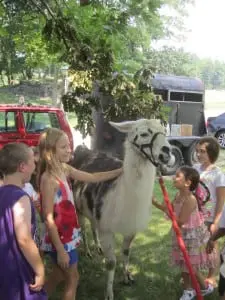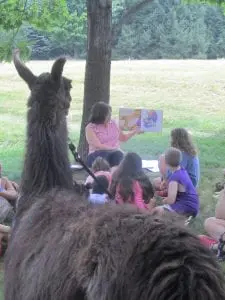Kids get up close and personal with South American mammals
By Alison Rooney
Noshing on the grassy fields behind the Desmond-Fish Library, a pair of llamas conjured up images of the Andes and offered up a novel way for local kids to spend a summer’s afternoon. “Dancer” and “Juliet,” female llamas from the Putnam Valley-located Hudson Valley Llamas, a rescue farm dedicated solely to llama rescues, entertained the children just by being themselves — gentle 250-plus-pound grazing animals who don’t mind being oohed and aahhed at, petted, and fed carrots.

In a special children’s program provided to the library by Ann Beddingfield, the llamas were brought over to Garrison by Gail and Michael Bennett, who run Hudson Valley Llamas, a hobby farm, out of devotion to the animals. After a petting session, the children enjoyed a reading of author Anna Dewdney’s Llama Llama Misses Mama, read by Lucille Merry, the children’s librarian. She also mentioned that Alice Curtis Desmond, a founder of the library, “who knew Peru,” had authored a book, which Merry displayed, called The Lucky Llama, about a llama who strays away from his herd.
“Dancer,” a 13-year-old with all-brown fleece, and “Juliet,” around 10 or 11 and brown and white, are two of the nine llamas the Bennetts currently care for on their property, where they range freely and have the use of a barn when it’s particularly snowy or inclement. Most of their rescues come to them from other farms, sometimes those going under, economically, or simply when the farmers become too old.

They are “always happy to take a few more,” citing the “fairly low maintenance” of taking care of these creatures. “They need fresh hay, and eat grain pellets containing oats, and our veterinarians have taught us how to give them the monthly shots they need for parasites.” They also get inoculated for rabies. Fleece is shorn seasonally in springtime, usually every two years, and is donated to the Bennetts’ local grange for fiber work.
After storytime, the Bennetts gave a little factual talk about llamas, where it was learned that:
- Llamas are related to camels.
- Llamas are different from alpacas in that they have more of a horse face and their ears are tall and shaped like bananas.
- They don’t have upper teeth. With big teeth on the bottom and a split lip on top, the llama has strong chewing teeth at the back of its mouth with which to rip out grass.
- Llamas have a one-year gestational period, and their usual lifespan is about 20 years.
- Llamas give birth standing up and the babies are born standing up as well, “all legs” and usually in the late afternoon.
- Unlike horses, llamas do not sleep standing up, but instead get into a position called “kush” in which they tuck down like kittens; sometimes they sleep on their sides.
- Llamas originated in the Great Plains of North America. Those which migrated to Asia became camels, and those which wound up in what is now South America became guanacos, vicuñas and alpacas as well as remaining llamas.
- Llamas like to roll over like dogs — especially right after a cleaning — they lay down and roll in the grass, where the dust cools them off.
- They don’t bite, but nibble. Sometimes male llamas which have not been gelded do attack other males. Usually this is preceded by spitting, and there is a whole range of spits, from, as Michael Bennett described it “air spits to something that comes from the deepest bowels of their third stomach that is so offensive that they themselves are offended by it.”
The Bennetts said that llamas were actually extremely affectionate, but on their own terms, much like cats.
Photos by A. Rooney

